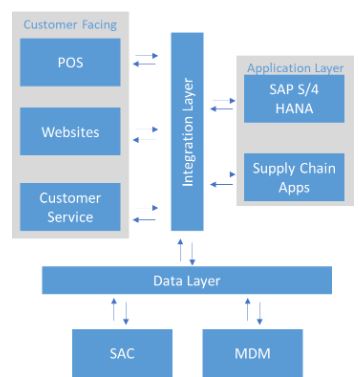As more and more retailers build strategies to address supply chain challenges, customer experience and ease of doing business, many have come to the realization that there may not be a single best solution for their various needs. This, coupled with point-of-sale (POS) requirements, and other unique industry challenges make the idea of a composable ERP solution a viable alternative. The traditional method of building out a single ERP solution to address as many needs as possible has several benefits but can be cumbersome and limit agility. Composable ERP is an adaptable technology strategy that allows for solving specific needs with different solutions with an overarching approach to data and integration that can make change easier and allow for faster overall response times to the ever-changing market.
To have a successful composable ERP strategy, there are several areas that need to be considered. A composable model can result in utilizing several systems, which brings risk to the overall application architecture. Solving for how data will be managed across several systems, how the integration layer will function, how to architect the overall solution design and reporting that meets business needs is critical to the composable strategy success.
Master data management
The composable model provides more flexibility across an evolving market where a retailer needs to constantly keep up with customer demands, needs and the newest trends. As the number of systems required to support the business’s needs increase, master data becomes fundamental to the success of the overarching strategy. Solving for how data will be managed and shared across platforms is the first step in a successful composable ERP strategy. Master data management is the process used to organize, manage, centralize and enhance core business data based on the rules, standards and mission for the enterprise. An organization must understand its enterprise data model, what types of data are being used and how the data is being used to drive revenue and operations. After defining a data governance strategy and identifying data of importance, the next critical step is identifying a system of record so there is a single source of truth moving forward. This will increase data accuracy, enrich analytical reporting and help adequately govern data as it moves to various systems across the landscape. All companies acknowledge the significance of data to their organization but identifying the real business issues and the data that should be prioritized is often the biggest challenge for organizations. Implementing a master data management strategy will result in increased data accuracy, informed decision-making, enhanced analytics and reduced manual efforts.
Integration layer
In a composable ERP strategy, there is potential for a number of systems to interact and send data back and forth. Given the open architecture, it is essential to develop an integration strategy to ensure data is sent between applications completely and accurately. Having proper controls in place to solve for how the various systems will interact with each other is necessary to ensure that transactions and data move quickly, consistently and accurately between systems. Not only does having an integration layer in place improve accuracy of data but it also increases automation, efficiency and scalability. Depending on the size and complexity of the environment, integration layers can be a long and expensive endeavor but as the number of systems in the environment increases, it is essential to move data throughout the systems. To implement a successful integration strategy, it is necessary to understand the data (i.e., source system, data type, etc.), profile and clean the data as a foundation. With a composable landscape, a strong integration strategy will reduce long-term maintenance and increase flexibility and ability to adapt to new systems and trends.

Solution design
When using a composable ERP landscape approach, it is necessary to look at the full end-to-end picture to understand which systems business processes will touch, how data will flow and how to report on key operational information. There are several areas of solution design focus that are instrumental in planning system architecture: key process activities, triggering events, data entities and attributes, business rules, systems of record, integration and reporting. Solution design provides the opportunity to thoughtfully evaluate key process enhancements and automation opportunities and refine the system architecture prior to beginning implementation activities. Leveraging a solution design methodology will define success in a composable landscape. Following this methodology will help deliver a solid baseline to define target operating models, dependencies for any system enhancements or implementations, and realistic timelines, costs and project plans. Most importantly, looking at the solution from a full end-to-end perspective solves complex business needs and ensures the system strategy is consistent with overall business objectives.

Analytics
The last major piece to a successful composable ERP strategy and implementation is analytics. Not only is having the right tools to automate and provide real-time reporting capabilities important, but so is leveraging the master data exercise to understand what data is important to the organization and where the data lives. Focusing on future state analytics early in the process is key to the composable ERP strategy and a critical element in the overall solution design. Start with the end in mind, as ensuring the retail business has the information it needs to identify new trends, adapt to changes and capture new opportunities as they arise, to ensure that the composable strategy is built in such a way to meet not just the operational reporting needs, but future state needs as well. The analytics strategy will help inform business decisions and is extremely important to a successful composable ERP landscape.
Overall, a composable ERP landscape provides many advantages for a retailer where user needs are constantly evolving and keeping up with the newest trends is necessary to stay relevant. At one retailer, Protiviti assisted in the development of a composable strategy to drive better forecasting and marketing activities by developing a roadmap that improved integration and visibility between point solutions for POS, warehouse, marketing, procurement and financial systems. To implement a successful composable ERP strategy, start with the end in mind and understand what you want your key business outcomes to be and tie these into your composable ERP strategy. If an organization decides a composable approach is the best path forward, it should focus on establishing an overall solution design, building in consideration of future state analytics into that design and then ensuring that the data and integration layers are adequate to support both. With the right attention on these areas, a retailer can help to ensure that the composable strategy is well thought out and executed.
Interested in learning more about our SAP consulting solutions? Contact us.






